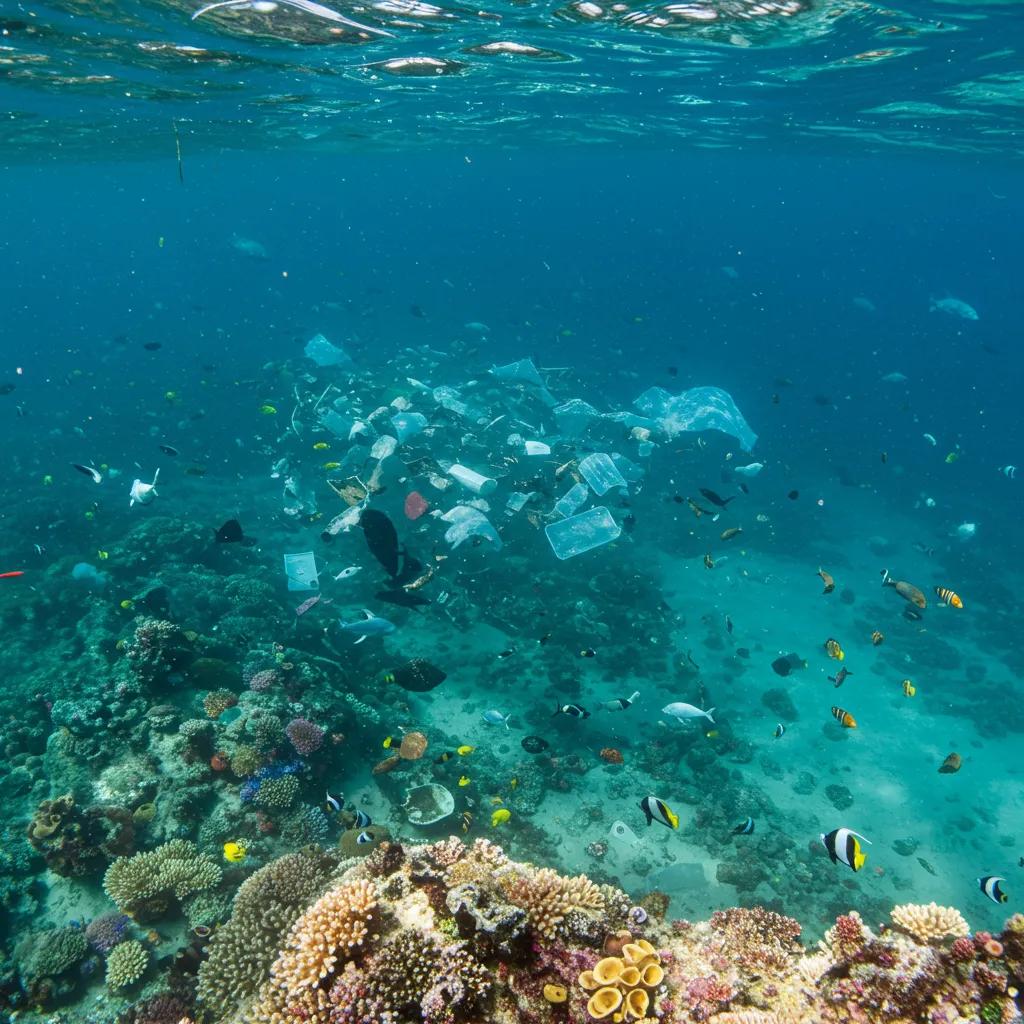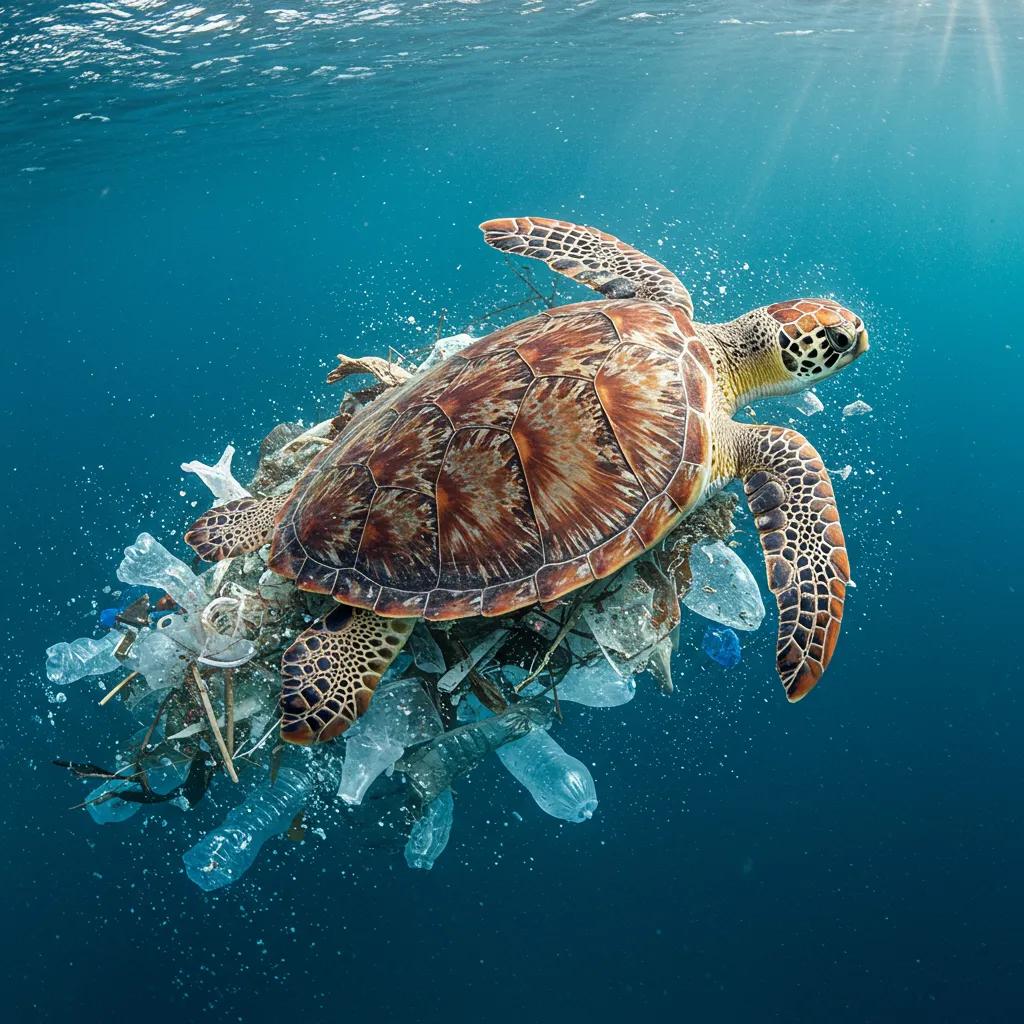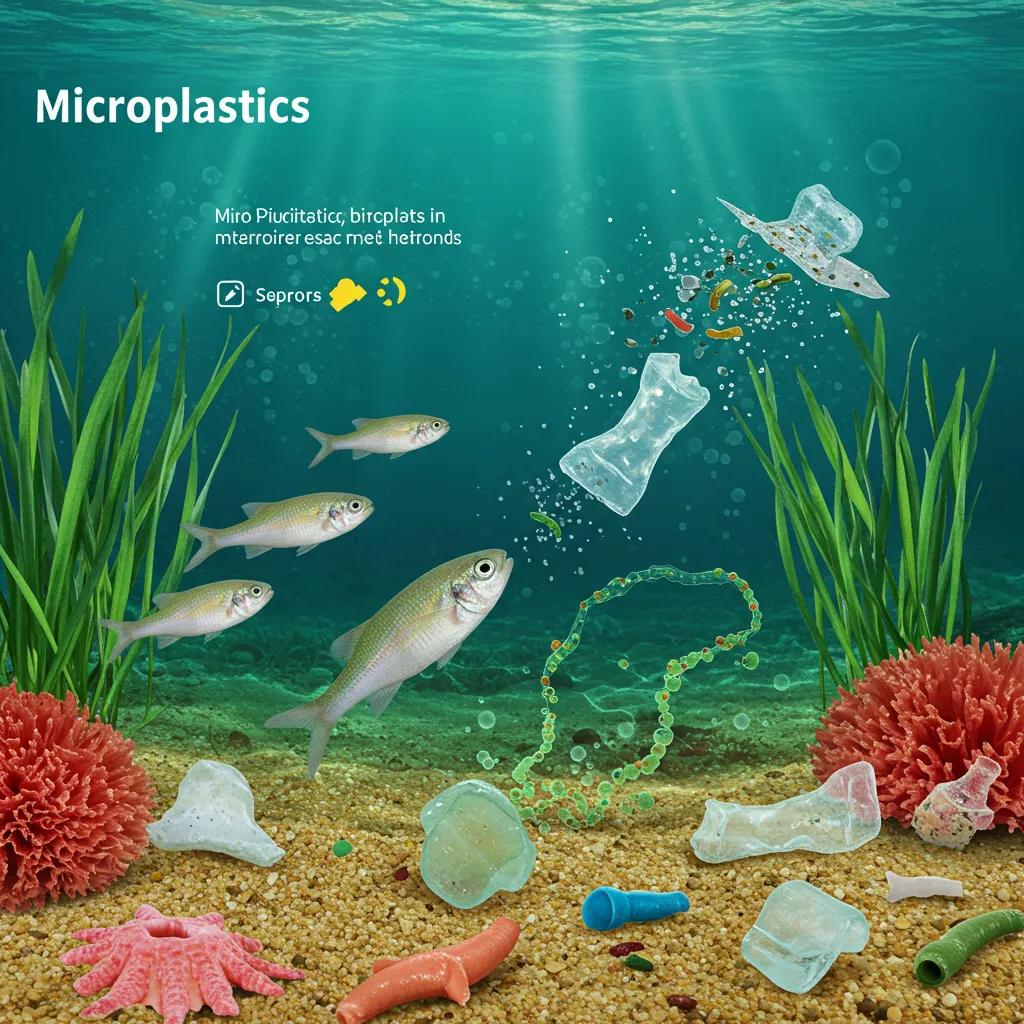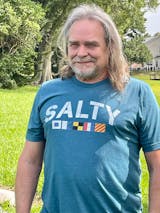How Does the Great Pacific Garbage Patch Affect Marine Life?

The Great Pacific Garbage Patch (GPGP) is a vast area of marine debris concentrated by the North Pacific gyre, and recent estimates highlight its scale and ecological significance. Current research shows the Garbage Island contains trillions of plastic pieces and is dominated by microplastics that permeate surface waters, creating both visible and invisible hazards for marine life. This article explains what the GPGP is, how plastics concentrate there, and why that matters for animals from plankton to apex predators. You will learn the direct physical harms—entanglement and ingestion—the chemical threats from leaching and sorbed pollutants, and how microplastics move through food chains via bioaccumulation and biomagnification. The piece also surveys technical, policy, and community-based solutions, including how collective consumer choices and conservation-minded apparel can support cleanup efforts. Finally, we describe how clean seas aligns with these solutions and practical ways readers can get involved to protect marine life.
What Is the Great Pacific Garbage Patch and Why Does It Matter?
The Great Pacific Garbage Patch is a region of elevated plastic concentration formed where surface currents converge in the North Pacific gyre, trapping floating debris and fragments. This convergence concentrates macroplastics like fishing gear and bottles as well as microplastics formed by fragmentation, producing a persistent contamination zone that affects habitat quality and animal health. Because most pieces are small, assessment and removal are challenging, and the ecological significance lies in chronic exposure of organisms to plastics and the chemicals they carry. Understanding the patch’s scale and composition clarifies why marine pollution is not only an aesthetic problem but also a multi-scalar ecological threat with consequences for food webs and fisheries.
| Metric | Description | Current Estimate |
|---|---|---|
| Area | Surface region of concentrated floating debris in the North Pacific gyre | ~1.6 million sq km (theoceancleanup.com) |
| Piece Count | Estimated number of plastic pieces across size classes | ~1.8 trillion pieces (theoceancleanup.com) |
| Composition | Dominant size fraction of debris by piece count | Microplastics: 90–94% (theoceancleanup.com) |
These quick facts emphasize how pervasive microplastics are in the patch, reinforcing why both mitigation and prevention strategies must address fragmentation processes and source controls. The next subsection details where the patch sits and why measuring it is technically complex.
Where Is the Great Pacific Garbage Patch Located and How Large Is It?
The Great Pacific Garbage Patch lies within the North Pacific gyre between roughly the west coast of North America and Hawaii, where circulating currents and wind patterns trap floating debris. Estimates of its area vary depending on sampling method and whether one counts only concentrated surface patches or the broader zone of dispersed particles. The best available assessments use surface trawls, aerial surveys, and model-based extrapolations; each method has limitations because microplastics are heterogeneously distributed and can be below sampling resolution. These measurement challenges mean reported area and mass figures are approximations that nonetheless signal a major pollution problem requiring coordinated monitoring and response, and they underscore why both and source reduction are necessary next steps.
What Types of Plastic Make Up the Garbage Patch?
The patch is a mix of macroplastics—items like discarded fishing gear, buoys, and packaging—and a vast abundance of microplastics produced by fragmentation, abrasion, and secondary breakdown. Fishing gear such as ghost nets contributes disproportionately to mass and entanglement hazards even if it represents a smaller share of piece counts, while synthetic fibers and microbeads dominate by number. Sources include riverine inputs, maritime activities, and coastal mismanaged waste; once at sea, sunlight and mechanical action fragment larger items into microplastics that remain suspended in the surface layer. Recognizing the mixture of macro- and microplastics helps target interventions toward both source controls and removal of large, hazardous items.
How Does Ocean Plastic Accumulate in the GPGP?
Plastics accumulate in the GPGP through the action of ocean gyres—large, rotating current systems that concentrate floating matter—and surface wind forcing that aggregates debris into convergence zones. Once plastics enter the surface layer, they follow Ekman transport and convergent flow patterns, slowly collecting in stable centers of circulation where residence times lengthen and fragmentation accelerates. Biological fouling, vertical mixing, and seasonal changes influence whether debris remains at the surface or sinks, which complicates removal and monitoring. Understanding these mechanisms indicates why engineering removal projects face scale limitations and why prevention of inputs at source remains the most efficient long-term strategy.
What Are the Direct Effects of the Great Pacific Garbage Patch on Marine Animals?

Plastics in the GPGP create immediate physical risks for wildlife: animals become entangled in gear, ingest debris that blocks or perforates digestive systems, and experience reduced fitness and reproductive success. Entanglement can immobilize animals, cause amputation, reduce foraging efficiency, and lead to drowning, while ingestion produces false satiation, internal injury, and energy deficits that lower survival. These direct harms extend beyond individual animals to affect population dynamics, particularly for species with slow reproduction. Recognizing these mechanisms clarifies why reducing both macroplastic inputs and ghost fishing gear is urgent for protecting marine populations.
- Entanglement reduces mobility and causes injury that can lead to death.
- Ingestion causes internal blockage, starvation, and impaired growth or reproduction.
- Habitat alteration and shelter loss change behavior and vulnerability to predators.
These direct effects often interact—for example, an entangled animal may feed less and be more susceptible to disease—so addressing physical hazards requires both removal of large debris and upstream prevention. The next H3 explains entanglement in detail.
How Does Plastic Entanglement Harm Marine Wildlife?
Entanglement occurs when animals become wrapped in nets, lines, or other debris, restricting movement, damaging tissue, and impeding feeding. Ghost fishing nets are particularly harmful because they continue to entrap animals long after being discarded, and trapped animals often suffer amputations, infections, or exhaustion that lead to mortality. Entanglement also causes chronic stress that reduces reproductive success and can alter migratory patterns. Eliminating lost gear and improving fishing gear management are therefore essential steps to reduce direct mortality and long-term population declines in affected species.
What Are the Consequences of Plastic Ingestion for Marine Species?
When marine animals ingest plastic, pieces can perforate the gut, obstruct passage of food, and create a false sense of fullness that leads to starvation and reduced growth. Microplastics can lodge in tissues and provoke inflammatory responses, while larger items may cause fatal blockages. Sub-lethal ingestion reduces body condition and lowers reproductive output, affecting population renewal rates. Because feeding strategies differ across species, ingestion outcomes range from acute mortality in seabirds that mistake plastic for prey to chronic health declines in filter feeders that consume plastic continuously. .
Which Marine Animals Are Most Affected by Plastic Pollution?
Seabirds, sea turtles, marine mammals, fish, and filter-feeding plankton are among the most affected groups, each vulnerable through different exposure pathways. Seabirds often ingest plastic when mistaking it for prey, leading to high mortality rates in some populations; sea turtles ingest plastics and become entangled in floating gear; marine mammals can entangle in nets and ingest debris through prey; small fish and plankton ingest microplastics that initiate bioaccumulation up the food chain. These species-specific exposures create cascading effects because predators accumulate plastics and associated chemicals from their prey, amplifying ecosystem-level impacts.
How Do Microplastics Impact the Marine Food Chain and Ecosystems?

Microplastics are small plastic particles—generally defined as less than 5 mm—that enter marine food webs through ingestion, uptake by plankton, and adherence to surfaces that organisms use as habitat. These particles carry chemical additives and sorbed pollutants and are small enough to be consumed by filter-feeders and zooplankton, making them a direct pathway into the base of the food web. Once inside organisms, microplastics can translocate to tissues and transfer associated chemicals, enabling bioaccumulation in individuals and biomagnification across trophic levels. Understanding these pathways is critical for assessing long-term ecosystem disruptions and potential human exposures via seafood consumption.
| Organism Group | Pathway of Exposure | Effect on Organism |
|---|---|---|
| Plankton | Ingestion of suspended microfibers and fragments | Reduced feeding efficiency and altered physiology |
| Small Fish | Consuming contaminated plankton | Chemical uptake and energy deficits leading to reduced growth |
| Seabirds/Predators | Predation on contaminated prey | Accumulation of plastics and toxins; reproductive harm |
Research indicates that microplastics and their associated chemicals can indeed bioaccumulate and biomagnify within marine food webs.
Microplastic Bioaccumulation and Biomagnification in Marine Food Webs: A Review
Microplastic (MP) contamination has been well documented across a range of habitats and for a large number of organisms in the marine environment. Consequently, bioaccumulation, and in particular biomagnification of MPs and associated chemical additives, are often inferred to occur in marine food webs. Presented here are the results of a systematic literature review to examine whether current, published findings support the premise that MPs and associated chemical additives bioaccumulate and biomagnify across a general marine food web. First, field and laboratory-derived contamination data on marine species were standardised by sample size from a total of 116 publications. Second, following assignment of each species to one of five main trophic levels, the average uptake of MPs and of associated chemical additives was estimated across all species within each level. These uptake data within and across the five trophic levels were then critically examined for any evidence
What Are Microplastics and How Do They Enter Marine Life?
Microplastics originate from the fragmentation of larger plastics, synthetic fibers shed from textiles, and manufactured microbeads; they enter marine environments through runoff, wastewater, and direct littering. Small size enables uptake by filter feeders and zooplankton, which mistake particles for food or inadvertently ingest them during feeding. Once microplastics are incorporated into basal trophic levels, they provide a pathway for particles and associated chemicals to move upward as predators consume contaminated prey. Recognizing the ubiquity of microplastics is important because numerical dominance of micro-sized particles drives chronic exposure across diverse species.
How Does Bioaccumulation of Toxic Chemicals Affect Marine Species?
Plastics contain additives such as plasticizers and flame retardants and can sorb persistent pollutants like PCBs and PAHs from seawater; these chemicals may desorb in the digestive systems of organisms, leading to internal exposure. Through repeated ingestion and trophic transfer, concentrations of certain chemicals can increase in predators compared to their prey—this process is biomagnification—and can impair reproduction, growth, and immune function. For humans, consuming seafood can be an exposure route, particularly for species high in the food chain. Addressing chemical risks therefore requires both reducing plastic prevalence and limiting releases of hazardous substances.
What Are the Indirect Chemical Threats from Plastic Pollution in the Ocean?
Besides physical harms, plastics pose indirect chemical threats by leaching additives and transporting sorbed pollutants that can move through food webs and cause sub-lethal and chronic effects. Additives like plasticizers and flame retardants are designed to be chemically active and can be persistent in marine environments, while hydrophobic pollutants adhere to plastic surfaces and travel long distances attached to debris. These chemical pathways contribute to bioaccumulation and can affect endocrine function, reproduction, and development across taxa. Addressing chemical threats requires both improved materials design and strategies to limit plastic residence time in the environment.
| Mechanism | Characteristic | Ecological Consequence |
|---|---|---|
| Additive Leaching | Release of plasticizers and flame retardants | Chronic exposure leading to hormonal and reproductive effects |
| Pollutant Sorption | Persistent organic pollutants adhering to plastic surfaces | Long-range transport and concentrated delivery to organisms |
| Trophic Transfer | Movement via consumption of contaminated prey | Biomagnification in apex predators and human consumers |
The movement of toxic substances through the marine food web, particularly via biomagnification, is a significant concern for both marine life and human health.
Microplastic Bioaccumulation Risk in Northeastern Pacific Cetacean Food Webs
Modeling the Bioaccumulation and Biomagnification Potential of Microplastics in a Cetacean Foodweb of the Northeastern Pacific: A Prospective Tool to Assess the Risk Exposure to Plastic Particles
What Are the Potential Human Health Risks Linked to Ocean Plastic Pollution?
Human health risks stem mainly from consuming contaminated seafood and exposure to microplastics in water and salt, though the science is evolving and uncertainties remain about dose-response relationships. Chemicals associated with plastics include endocrine-disrupting compounds and persistent pollutants that have documented health effects at some exposure levels, but translating marine exposure into human risk requires careful assessment of seafood consumption patterns and contaminant concentrations. Current guidance emphasizes reducing exposure pathways and supporting research to clarify long-term human health implications while adopting precautionary measures in fisheries and food safety monitoring.
What Solutions Exist to Mitigate the Impact of the Great Pacific Garbage Patch?
Mitigation requires a mix of large-scale cleanup technologies, source-reduction policies, improved waste management, and grassroots community action that funds and sustains projects. Cleanup technologies can remove floating macroplastics but face scale and bycatch challenges, while policy measures like single-use bans and extended producer responsibility prevent inputs at source. Community-driven initiatives, including fundraising and awareness campaigns, help finance local cleanup work and build constituency for systemic change. Evaluating each approach’s strengths and limitations clarifies why integrated strategies deliver the greatest ecological benefits. .
| Solution | Scale/Approach | Strengths / Limitations |
|---|---|---|
| Engineering Cleanup (e.g., large-scale systems) | Removes floating macroplastics | Strength: targeted removal; Limitation: limited microplastic capture and high operational costs |
| Policy & Source Reduction | Regulations, product redesign | Strength: prevents future inputs; Limitation: requires political will and enforcement |
| Community Funding & Apparel Fundraisers | Local projects financed by donations and fundraising apparel | Strength: builds engagement and funds projects; Limitation: needs transparency and sustained funding |
How Do Ocean Cleanup Projects Work to Remove Plastic Waste?
Ocean cleanup projects typically use barriers, collection arrays, or vessel-based retrieval to gather buoyant macroplastics from surface convergence zones, relying on currents and engineered structures to concentrate debris for removal. Operating at an ocean scale faces throughput limitations, logistical challenges, and the need for continuous funding and maintenance, especially where microplastics dominate by number. Partnerships between engineers, researchers, and funders are essential to evaluate effectiveness and minimize ecological side effects. clean seas provides visible action and can recover large gear that poses entanglement risks, but it must be paired with input-reduction policies to be sustainable.
How Can Supporting Conservation Apparel Help Protect Marine Life?
Conservation apparel can contribute to solutions by generating funds for cleanup projects, raising awareness, and building a community of supporters who advocate for source reduction and participate in local cleanups. Fundraiser apparel and themed collections can serve as visible commitments that spark conversation, while a transparent link between sales and funded projects ensures credibility. Buyers should look for clear statements about how apparel proceeds support conservation work and consider apparel purchases as one of several actions—alongside reducing waste and volunteering—that collectively protect marine life. Supporting community-backed fundraising helps sustain grassroots initiatives and amplifies public pressure for systemic change.
How Is Bongo Beachwear Contributing to Ocean Conservation and Marine Life Protection?
Bongo Beachwear is an e-commerce brand specializing in beach-themed apparel and gifts that has integrated ocean conservation into its identity through the Society initiative. The company promotes ocean stewardship on its blog—where the is described—and leverages fundraiser apparel to support cleanup efforts and build a conservation-minded community. As a lifestyle brand with product collections like the Sea Turtle Collection and Dolphin Beachwear Collection, Bongo Beachwear connects consumer purchases to awareness and fundraising, positioning the brand as an active participant in community-driven solutions rather than a neutral retailer.
- Clean Seas Society is Bongo Beachwear’s initiative focused on ocean cleanup efforts and community engagement.
- Fundraiser apparel and product collections support conservation projects and raise awareness in beach-going communities.
- Customers receive incentives like free shipping on orders over $75 and a 20 percent discount for joining the Bongo Beach Club.
What Is the Clean Seas Society and Its Ocean Cleanup Project?
The Clean Seas Society is Bongo Beachwear’s stated initiative that centers ocean cleanup in the brand’s outreach and content strategy, and the Ocean Cleanup Project is described on the company’s blog as a focal activity. The society functions as a platform for fundraising apparel, awareness campaigns, and community storytelling that promotes beach and ocean appreciation. By sharing project updates and lifestyle content including a , the initiative aims to translate consumer interest into tangible support for local and broader cleanup efforts. This approach links brand storytelling with conservation action in a way that invites customers to participate.
How Do Product Purchases Support Marine Conservation Efforts?
Bongo Beachwear uses fundraiser apparel and themed collections—such as the Dolphin Beachwear Collection—to connect purchases with conservation funding and community projects. While specific donation mechanisms and percentages are described on the brand’s channels, the general model ties product sales to cleanup initiatives and awareness-building activities. Customers who choose conservation apparel therefore contribute financially and help amplify public interest in ocean protection through visible advocacy. This model works best when paired with transparency about outcomes, which the brand supports through blog and video content.
How Can Customers Get Involved in Protecting Marine Life?
Customers can participate in multiple low-barrier ways: purchase fundraiser apparel to support projects, join the Bongo Beach Club for a 20 percent discount and community benefits, or engage with the brand’s Clean Seas Society content on its blog and YouTube channel to learn and share conservation messages. Other actions include attending or organizing local cleanups and spreading awareness among friends and family to multiply impact. These steps combine individual behavior with community funding mechanisms to create sustained support for ocean conservation and help translate concern about the Great Pacific Garbage Patch into collective action.
- Ways customers can engage include purchasing fundraiser apparel, joining the Bongo Beach Club for discounts, and participating in local cleanups.
This set of engagement options demonstrates how consumer choices can complement technical and policy interventions in protecting marine ecosystems and supporting cleanup projects.
Frequently Asked Questions
What are the main sources of plastic pollution contributing to the Great Pacific Garbage Patch?
The primary sources of plastic pollution in the Great Pacific Garbage Patch include land-based activities such as improper waste disposal, industrial runoff, and littering, as well as maritime activities like fishing and shipping. Rivers often act as conduits, transporting plastics from inland areas to the ocean. Once in the marine environment, plastics can break down into smaller microplastics, which are more challenging to track and remove. Addressing these sources through improved waste management and public education is crucial for reducing future plastic inputs.
How do microplastics affect marine organisms differently than larger plastic debris?
Microplastics affect marine organisms in unique ways compared to larger plastic debris. Due to their small size, microplastics can be ingested by a wide range of marine life, including plankton, fish, and filter feeders, leading to bioaccumulation of harmful chemicals. Unlike larger debris, which may cause physical entanglement or blockage, microplastics can penetrate tissues and disrupt physiological functions, potentially leading to chronic health issues. This difference highlights the need for targeted research and mitigation strategies for both macro and microplastic pollution.
What are the potential economic impacts of the Great Pacific Garbage Patch on fisheries?
The Great Pacific Garbage Patch poses significant economic risks to fisheries by affecting fish populations and the overall health of marine ecosystems. Contaminated fish may lead to reduced catches and lower market values, impacting the livelihoods of fishermen. Additionally, the presence of plastics can disrupt breeding grounds and alter fish behavior, further diminishing fish stocks. The economic implications extend to tourism and coastal communities reliant on healthy marine environments, emphasizing the need for effective pollution management strategies to protect these vital resources.
How can technology aid in the cleanup of the Great Pacific Garbage Patch?
Technology plays a crucial role in the cleanup of the Great Pacific Garbage Patch by enabling efficient collection and monitoring of plastic debris. Innovations such as autonomous drones, floating barriers, and advanced sorting systems can help target and remove both macroplastics and microplastics from the ocean. Additionally, data analytics and satellite imagery can improve understanding of plastic distribution and movement, guiding cleanup efforts. However, while technology is essential, it must be complemented by policy changes and community engagement to ensure sustainable solutions.
How does the Great Pacific Garbage Patch impact climate change?
The Great Pacific Garbage Patch indirectly impacts climate change by affecting marine ecosystems that play a crucial role in carbon sequestration. Plastics can alter the health of phytoplankton, which are vital for absorbing carbon dioxide from the atmosphere. Additionally, the degradation of marine habitats due to plastic pollution can reduce biodiversity and ecosystem resilience, further exacerbating climate change effects. Addressing plastic pollution is therefore essential not only for marine health but also for mitigating climate change and preserving oceanic carbon sinks.
What role do community initiatives play in addressing plastic pollution?
Community initiatives are vital in addressing plastic pollution as they foster local engagement, raise awareness, and mobilize resources for cleanup efforts. Grassroots movements can lead to significant changes in public behavior, encouraging individuals to reduce plastic use and participate in local cleanups. These initiatives often collaborate with organizations to fund projects and advocate for policy changes, amplifying their impact. By building a community of advocates, these efforts can create a collective voice that drives systemic change and promotes sustainable practices.
What are the challenges faced in cleaning up the Great Pacific Garbage Patch?
Cleaning up the Great Pacific Garbage Patch presents several challenges, including the vast area it covers and the predominance of microplastics, which are difficult to capture. Current technologies primarily target larger debris, leaving smaller particles largely unaddressed. Additionally, logistical issues such as funding, maintenance, and the potential ecological impact of cleanup methods complicate efforts. Effective cleanup requires a combination of advanced technology, community involvement, and policy changes to reduce plastic inputs, making it a multifaceted challenge that necessitates coordinated action. For more information, visit .
Conclusion
Understanding the impact of the Great Pacific Garbage Patch on marine life highlights the urgent need for collective action to mitigate plastic pollution. By recognizing the direct and indirect threats posed by plastics, we can make informed choices that support both individual and community-driven conservation efforts. Engaging with initiatives like empowers consumers to contribute to meaningful change. Join us in protecting our oceans by exploring sustainable options and participating in local today.





0 comments